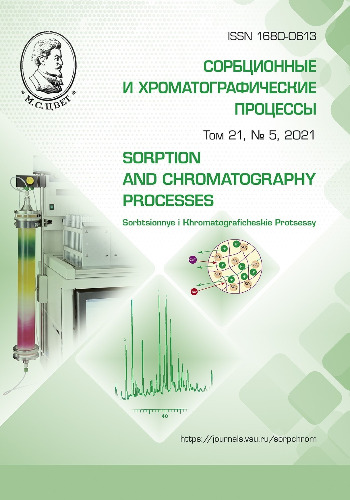Composite materials based on Nafion membrane and poly(3,4-ethylenedioxythiophene) for the potentiometric identification of sulphanilamides
Abstract
Sulfanilamide and sulfacetamide are important analytes due to the fact that they are widely used in antimicrobial pharmaceuticals. Sulfanilamide pharmaceuticals are usually analysed by means of potentiometric sensors based on ionophores. The use of ionophores in potentiometric sensors is associated with a number of problems, while the choice of compounds capable of ion exchange reactions or complex formation with anions is limited. The number of ion exchange membranes with nanostructured matrices and chemical resistance is also rather small. In our study, in order to determine sulfanilamides, we used alkali metal cations together with a multisensory approach based on arranging the sensors with cross-sensitivity to several analytes into an array. Multisensory systems included potentiometric sensors, whose response is the Donnan potential (DP), with internal comparison solution based on perfluorinated perfluorosulfonic acid membranes «Nafion». Since sulfacetamides enter the cation-exchange membrane through non-exchange sorption, the increase in their concentration in the pores may be facilitated by ion-ion and ion-dipole interactions, as well as by hydrophobic interactions with the components of the membranes. Therefore, the purpose of our study was to develop multisensory systems based on Nafion membranes containing poly(3,4-ethylenedioxythiophene) (PEDOT) for the co-determination of sulfanilamide anions and alkali metal cations in aqueous solutions and pharmaceuticals.
We investigated the effect of the presence and concentration of PEDOT in Nafion membranes on the properties of the cross sensitivity DP-sensors. For the samples with low concentrations of the dopant (the samples were obtained by processing a 0.002 М monomer solution) and increased anion permeability, the sensitivity of DP-sensors to sulfanilamide anions increased. This is accounted for by the accessibility of proton-acceptor groups and fragments of π-conjugation of PEDOT as additional sorption centres for organic analytes. The study also determined that the presence of a mineral ion in the studied solutions different from initial ion type of the membrane can facilitate the increase in the sensitivity of DP-sensors to sulfanilamides. This happens as a result of their coupled transportation to the membrane due to the formation of hydrogen bonds between the hydration shells of counter- and coions.
Arrays of cross-sensitive DP-sensors based on composite membranes were tested during the analysis of model solutions with various concentration ratios of analytes and solutions of the pharmaceuticals “Sodium sulfacetamide” (eye drops). The relative error of the determination of the active substance in pharmaceuticals by OOO Groteks and FSUE Moscow Endocrine Plant as compared to the concentrations claimed by the manufacturer was 0.5 and 3%. The relative error was 5 and 7% as compared to the concentrations determined spectrophotometrically. Multisensory systems can be used to perform the analysis without significantly diluting and correcting the pH of the analysed objects. Furthermore, DP-sensors retain their characteristics for quite a long time because the components of the membranes are not spent during the measurements.
Downloads
References
Yadav S.K., Choubey P.K., Agrawal B., Goyal R.N., Talanta, 2014, Vol. 118, pp. 96-103. DOI: https://10.1016/j.talanta.2013.09.061.
Kamel A.H., Almeida S.A., Sales M.G.F., Moreira F.T., Anal Sci., 2009, Vol. 25, No 3,
pp. 365-371. DOI: https://10.2116/analsci.25.365.
Soleymanpour A., Rezvani S.A., Mater. Sci. Eng. C, 2016, Vol. 58, pp. 504. DOI: https://10.1016/j.msec.2015.08.034.
Kharitonov S.V., Gorelov I.P., Pharmaceutical Chemistry Journal, 2000, Vol. 34, No 12, pp. 673-676. DOI: https://10.1023/A:1010464120998.
Pechenkina I.A., Mikhelson K.N., Russian Journal of Electrochemistry, 2015, Vol. 51,
No 2, pp. 93-102. DOI: https://10.1134/S1023193515020111.
Mikhelson K.N., Peshkova M.A., Russian Chemical Reviews, 2015, Vol. 84, No 6, pp. 555-578. DOI: https://10.1070/RCR4506.
Yelnikova A.S., Kolganova T.S., Parshina A.V., Bobreshova O.V., Sorbtsionnye i Khromatograficheskie Protsessy, 2020, Vol. 20, No 5, pp. 615-623. DOI: https://10.17308/sorpchrom.2020.20/3054.
Safronova E., Parshina A., Kоlganova T., Yelnikova A., Bobreshova O. et al., J. Electroanal. Chem., 2020, Vol. 873, pp. 114435. DOI: https://10.1016/j.jelechem.2020.114435.
Titova T.S., Yurova P.A., Kolganova T.S., Stenina I.A. et al., Journal of Analytical Chemistry, 2020, Vol. 75, No 8, pp. 1072-1079. DOI: https://10.1134/S106193482008016X.
Cross R.F. Cao J., J. Chromatogr. A, 1998, Vol. 818, No 2, pp. 217-229. DOI: https://10.1016/S0021-9673(98)00554-8.
Ahmed S., Anwar N., Sheraz M.A., Ahmad I., J. Pharm. Bioallied Sci., 2017, Vol. 9, No 2, pp. 126-134. DOI: https://10.4103/jpbs.JPBS_184_16.







